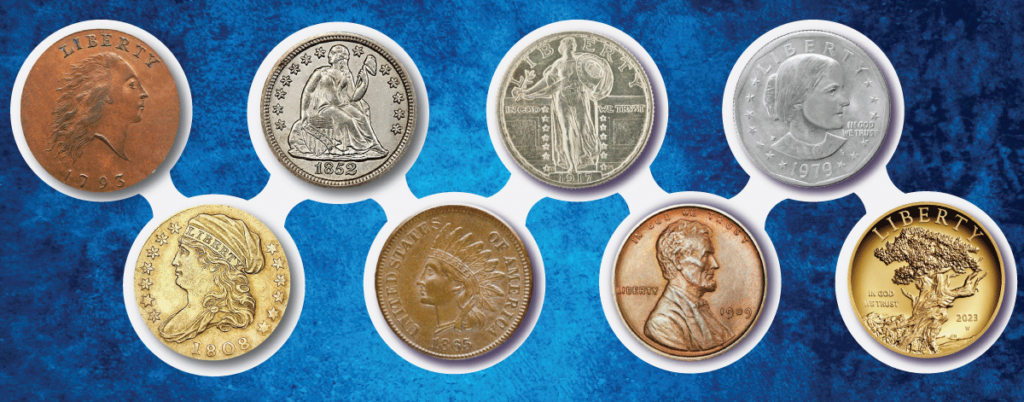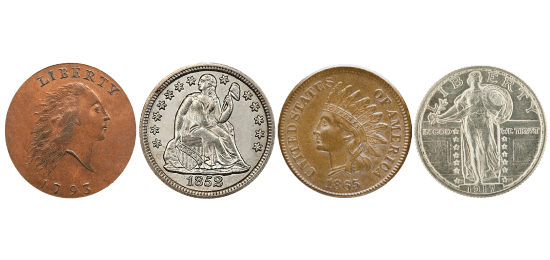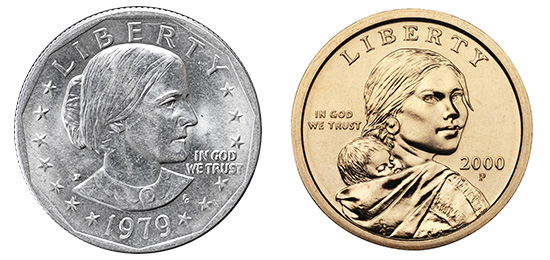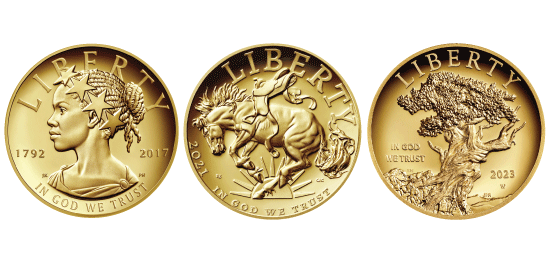By Stephanie Meredith
January 3, 2024

Throughout the history of this country, the concept of liberty has been a defining principle. Depictions of liberty appear in the halls of Congress, on a large statue in New York harbor, and on our coins. Representations have evolved over the centuries to reflect a changing America. U.S. coinage echoes more than 230 years of the country’s visions of Liberty, from a mythical goddess to presidents and historical figures.
Liberty, and America itself, has often been represented as an allegorical figure. In the early colonial period, the American colonies were depicted in newspapers, engravings, and other media as the figure of a Native American woman. As calls to break from Great Britain rose in the 18th century, the colonists used the Native American figure as Liberty, a symbol of freedom. During the same time, a neoclassical revival increased interest in ancient Greece and Rome. This caused the image of Liberty to evolve into a Greco-Roman goddess. Her facial features became distinctly Roman and she wore classically-styled gowns and sandals.
After the Revolutionary War, the connection to Liberty continued in American culture. The Fugio cent, the first coin commissioned by the U.S. government under the Articles of Confederation, reflects this sentiment.
Early Liberty

When creating legislation for a national mint in 1792, Congress decided that coins should continue to represent the concept of liberty on the obverse rather than a real person. Many felt that putting presidents on U.S. coins was too similar to Great Britain’s practice of featuring their monarchs. Instead, they wanted coins to reflect the country’s founding principal of liberty.
The Coinage Act of 1792 stated that all circulating coins have an “impression emblematic of liberty” and the inscription “Liberty.” For more than 100 years of American coinage, that emblem would be the mythical goddess Liberty.
The U.S. Mint’s first coins were portraits of Liberty with free, flowing hair, such as the 1793 Flowing Hair cent. As the Mint refined its process, more detailed versions appeared beyond the simple portrait. Designs featured classical symbols such as the liberty cap and pole, used frequently when representing Liberty during the Revolution. In ancient Rome, the cap was given to freed slaves and the pole was used in the ceremony to free them.
Starting in the mid-19th century, the images of Liberty started to reflect a change in how American culture defined itself. Coin designs incorporated American symbols into the classical style. The Seated Liberty coins feature the Union Shield, adapted from the Great Seal of the United States.
Coins then started to draw on Native American themes for an even more American identity. In 1859, the Indian Head cent depicted Liberty wearing a Native American chief’s headdress. The Buffalo nickel in 1913 went even further, replacing Liberty with the portrait of a Native American man.
Another shift happened in the early 20th century when President Theodore Roosevelt wanted coins with more artistry that reflected a national identity and America’s growth as a global power. The first coin to meet this directive was designed by one of the leading sculptors of the day, Augustus Saint-Gaudens. The 1907 $20 Double Eagle is regarded as one of the most beautiful coins in Mint’s history. Sculptors Adolph A. Weinman and Hermon A. MacNeil redesigned other circulating coins in 1916.
Saint-Gaudens, Weinman, and MacNeil reflected an America built upon classical, republican ideals from ancient Greece and Rome where liberty is central. In their reflection of America as a global power, Liberty displays military might with shields, but also brings peace and enlightenment to the world with other symbols.
Presidents as Liberty
In addition to those nationalistic feelings of the early 1900s, opinions about featuring real people on coins changed. In 1909, President Abraham Lincoln replaced the figure of Liberty on the penny in honor of his 100th birthday. The rest of the circulating denominations changed throughout the 20th century to show other presidents, and the goddess Liberty disappeared from circulating coinage. In 1971, with the release of the Dwight D. Eisenhower dollar, all the circulating coins featured presidents.
Legislation still required the obverse of coins to represent the concept of liberty, but instead of a mythical figure, the presidents became that depiction. Presidents continue to represent liberty on today’s penny, nickel, dime, quarter, and half dollar.
Women as Liberty

In the more than 230 years of American coinage, only two women have appeared on the obverse of circulating coins. In 1979, Susan B. Anthony became the first woman featured on a U.S. circulating coin. The Susan B. Anthony dollar showed a portrait of Anthony on the obverse as a new emblem of liberty. The Mint issued the dollar from 1979 to 1981 and again in 1999.
The Mint released a new dollar in 2000, again representing liberty as a woman. The Sacagawea Golden Dollar showed Sacagawea in three-quarters profile, carrying her baby Jean Baptiste on her back. The Mint made the dollar until 2008. In 2009, the Sacagawea obverse was carried over into the Native American $1 Coin Program. The Mint issues a new coin in the program each year.
Modern Representations of Liberty

In 2015, the U.S. Mint released the first coin in a series of gold coins and silver medals aimed at modern interpretations of the concept of liberty. The first three designs of the American Liberty program show new takes on the traditional Liberty figure. The second of those designs, the 2017 American Liberty 225th Anniversary Gold Coin, depicts Liberty as an African American woman for the first time. She’s shown in profile with a crown of stars.
The 2021 coin, the fourth design in the American Liberty series, moves away from people completely. The obverse design shows liberty as a wild American Mustang horse bucking off a western saddle. The bucking mustang is symbolic of throwing off British rule during the American Revolution.
The 2023 American Liberty design depicts liberty as a bristlecone pine tree, thought to be one the oldest living organisms on Earth. These trees grow in places where other plants cannot, and are often the first to regrow after cataclysmic changes to the landscape. The American Liberty program continues to reimagine the interpretation of what liberty is in the 21st century.
What will liberty evolve into next?
See more Inside the Mint articles.


